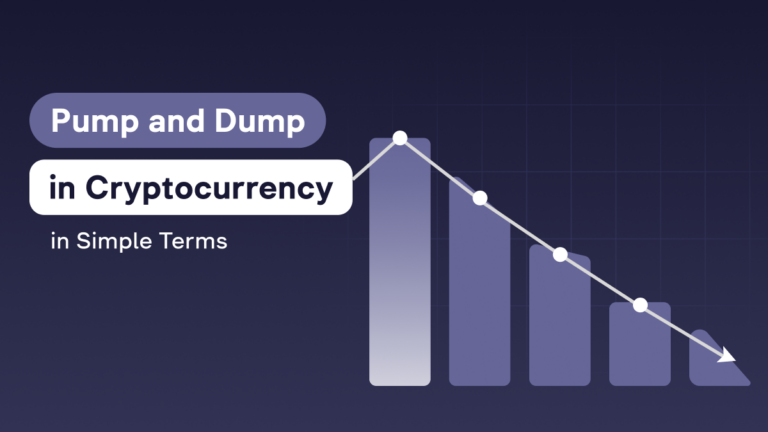What Is Liquidity in Cryptocurrency?

Content
One of the values of all assets in the financial world is the ability to sell and buy quickly. The term “liquidity” (from Latin liquidus “liquid, flowing”) means the property of assets that easily “flow” from hand to hand while maintaining a value close to the market value. Such assets are called liquid. The easier and faster an asset can be exchanged, the more liquid it is.
In the context of cryptocurrencies, understanding liquidity is particularly important because it affects the ability of investors and traders to manage their portfolios effectively in a dynamically changing market. What is crypto liquidity? What influences cryptocurrency liquidity? How important is it? What risks does low liquidity carry? About all this in our article.
What Does Liquidity Mean in Crypto?
Cryptocurrency liquidity is the ability of a cryptocurrency to be exchanged quickly in the market at the current price without significant loss of value. Unlike traditional finance, the crypto market encompasses a broader spectrum of liquidity types. This spectrum includes exchange liquidity, which ensures quick transactions with minimal price fluctuations; asset liquidity, which indicates the availability of cryptocurrencies; network liquidity, which reflects the volume of transactions on the blockchain; liquidity in DeFi; and stablecoin liquidity. Liquidity is critical in maintaining market stability and minimizing volatility, but what affects it?
Factors Influencing Crypto Liquidity
- The popularity of the asset. The more popular an asset is, the more people are willing to sell or buy it. The presence of an asset on various centralized and decentralized exchanges increases its availability to a wide range of investors. Centralized exchanges (CEX) offer convenience and speed of trading, while decentralized exchanges (DEX) offer transparency and reliability, allowing users to control their funds. The diversity of trading venues contributes to a more even liquidity distribution, making the market more stable and adaptive.
- Trading volume. The larger it is, the easier it is for sellers and buyers to close a deal.
- The value of the asset and its development. Projects with a clear mission and potential for growth increase interest in trading the asset.
- Market Structure. An efficient structure speeds up the transaction process. Limit orders, low commissions, and crypto market making services provide the necessary liquidity crypto and reduce spreads, which makes trading more accessible and profitable for all participants.
- Regulatory environment: Cryptocurrency regulation has a dual impact on liquidity. On the one hand, a clear regulatory framework increases investor confidence, attracting new capital to the market and maintaining its stability. On the other hand, overly strict or ambiguous regulation can stifle innovation and limit access to new entrants, negatively impacting overall liquidity. A balance in regulation helps create a healthy and dynamic market environment, supporting the growth and development of the cryptocurrency sector.
The Main Signs of High and Low Liquidity
Although assets are divided into liquid and illiquid, liquidity is only sometimes clearly defined in cryptocurrencies. The liquidity issue disappears for small trades, such as buying $100 worth of cryptocurrency. However, when managing millions, it becomes more difficult to trade assets due to fewer buyers or sellers.
Bitcoin holds the position of the most liquid cryptocurrency, which is due to its high popularity, significant market cap, and availability on all leading exchanges. However, while Bitcoin’s high liquidity seems obvious, the criteria for assessing the liquidity of altcoins is more complex.
Key indicators of high liquidity:
- Narrow spreads: Indicates the minimal difference between the bid and ask prices, indicating market efficiency and low transaction costs;
- High trading volume: Indicates the activity of market participants and the market’s ability to support large transactions without significant price impact;
- Fast order execution: Emphasizes the efficiency of the market in connecting buyers and sellers instantly, minimizing waiting time;
- Lack of frequent squeezes (price spikes): Refers to the rarity of candles with long shadows on the chart, indicating the absence of sharp and unwarranted price swings often associated with low liquidity;
- Price stability after executing large orders: The market can absorb large trades without dramatic price fluctuations, providing confidence in price stability.
Key indicators of low liquidity:
- Wide spreads: This means a significant difference between buy and sell prices, which may indicate low activity in the market or a limited number of participants willing to trade;
- Slow order execution: An indication that buy or sell orders remain unexecuted for a long time due to lack of suitable bids;
- Volatility with low transaction volumes: Small trades can cause disproportionately large price fluctuations, indicating that the market is sensitive and unable to absorb even small orders without significantly impacting cryptocurrency prices;
- Low trading volume: This indicates a lack of investor interest or confidence in the market, which can lead to additional difficulty in finding counterparties for trades.
Importance of Liquidity in Cryptocurrency and Its Benefits
Liquidity in cryptocurrency plays a key role in making the asset more attractive to investors due to several significant advantages. One such advantage is price stability and reduced volatility, which makes market manipulation much more difficult. Narrow spreads between buy and sell prices minimize trading costs, making the market more accessible and attractive to various participants.
High cryptocurrency liquidity also facilitates efficient analysis of market behavior that reflects the actual supply and demand balance, leading to improved market efficiency through fast and fair trade execution. This makes it easier for large investors and institutional participants to enter and exit prominent positions without significantly impacting prices, attracting more participants to the market and increasing its stability and reliability.
In addition, high crypto liquidity facilitates the close integration of the cryptocurrency market with traditional financial systems, strengthening its role in the global economy. Improved predictability and planning for all market participants contribute to the sustainable development and growth of the cryptocurrency sector, making it more resilient and attractive for new investments.
Risks and Challenges of Low Liquidity
Low liquidity of cryptocurrency markets is a severe problem for investors and traders alike, as it jeopardizes the stability of these markets. Difficulty selling or buying assets without significantly affecting their price can lead to sudden and unpredictable price fluctuations, increasing investment risk.
One of the main problems of low liquidity is price “slippage,” where orders are executed at a significantly changed rate, which can negatively affect the outcome of trades. In addition, the limited trading volume makes the market vulnerable to manipulation, allowing manipulators to easily influence prices and create a distorted view of market trends.
Various factors could trigger a liquidity crisis, including mass withdrawals from exchanges, resulting in a cash shortage to process withdrawal requests. Regulatory changes or news of hacking attacks could cause panic among investors, drastically reducing crypto exchange liquidity. Also, problems with major market participants can undermine confidence in the cryptocurrency sector, reducing activity and liquidity in the market.
How to Measure Cryptocurrency Liquidity in a Market?
Measuring cryptocurrency liquidity in the market involves analyzing key indicators. Bid-ask spread indicates the difference between buy and sell prices, displaying the availability of the asset. Order book market depth demonstrates the volume of orders at different prices, helping to understand the market’s ability to absorb large trades. Price slippage reflects the difference between the expected and actual order execution price, which is essential for estimating the cost of executing trades. Trading volume shows activity in the market, confirming interest in the currency.
It is also essential to look at the distribution of trading volumes and the activity of market makers, which helps assess liquidity stability. Comparing the liquidity of an asset on different exchanges reveals the most suitable platforms for trading. Taking into account temporal and geographical factors helps to understand liquidity fluctuations.
This comprehensive analysis provides traders and investors with a multidimensional understanding of liquidity, allowing them to minimize risk and increase profit potential.
Liquidity of Different Cryptocurrency Assets
Their liquidity level can classify cryptocurrencies into three categories: high, medium, and low.
As already mentioned, the leader in terms of liquidity in the cryptocurrency market is Bitcoin (BTC). The second place is occupied by Ethereum (ETH). The top 10 also includes such assets as LTC, XRP, XLM, TRX, ETC, and ATOM.
The liquidity of stablecoins is also worth noting, as they are also a cryptocurrency, though not an investment currency. Stablecoins such as USDT and USDC have much more liquidity than other cryptocurrencies due to price stability.
Older cryptocurrencies such as DOGE, DASH, LINK, and EOS often have average liquidity. Such cryptocurrencies are in the top 100 in capitalization but are not traded on all exchanges.
Crypto assets with the lowest liquidity are usually only available on one or more specialized exchanges. Meme tokens and fan tokens usually boast the most inferior liquidity. Their primary use is for speculative transactions with small amounts, and it is a bad idea to buy them for investment purposes.
Strategies to Improve Crypto Market Liquidity
- Collaboration with Market Makers (AMMs)
AMMs enable automatic digital asset trading without a traditional intermediary, guaranteeing continuous liquidity on decentralized exchanges. Project teams and exchanges can integrate with AMMs like WhiteSwap to allow continued trading of their tokens. The institutional crypto platform also plays a significant role in the AMM ecosystem.
- Liquidity mining
Liquidity mining is rewarding users for providing their assets to a liquidity pool. Such a strategy motivates token holders to lock their funds into AMM, increasing the available liquidity for trading. In return, participants receive a percentage of transaction fees or new tokens. This creates a win-win situation for all participants in the ecosystem.
- Incentivize institutional participation
Developing a robust regulatory and operational framework that meets high-risk management and return assurance requirements is necessary to attract institutional investors. This includes creating products tailored to the needs of institutional investors. It is also essential to seek to build the confidence of these investors, primarily through improved security and transparency in all transactions.
- Affiliate programs and listings
Partnering with other exchanges, financial platforms, and crypto listing can significantly increase liquidity. In addition to expanding market reach, it also improves the perception of the assets among a wider audience. Strategic partnerships can include joint marketing promotions and integrations to attract new users and investors.
- User Experience Optimization
Improving the interface and user experience on the platform can significantly enhance liquidity by making it easier for users to trade and interact with assets. Incorporating additional features such as liquidity aggregation, improved analytical tools, and educational resources can help retain users and attract new ones.
How to Prevent Liquidity Crises in Crypto?
Preventing a liquidity crisis in cryptocurrency exchange liquidity requires a comprehensive approach that includes strengthening transparency and trust in the ecosystem, actively engaging institutional and retail investors, and establishing partnerships with automated market makers to guarantee consistent liquidity on decentralized exchanges. Developing incentives for participation in liquidity mining, which incentivizes increased available funds for trading, is also key. Improving the user experience to simplify trading processes and lower the entry threshold for new market participants is essential.
Conclusion
Cryptocurrency liquidity, in simple words, is a crucial aspect that determines stability and confidence in the market. It ensures the convenience of trading and contributes to effective pricing. Understanding the factors affecting liquidity and identifying signs of its level helps assess risks and investment opportunities. Developing strategies to improve liquidity requires a collaborative effort among market participants, including project teams, investors, and regulators. Thus, a deep understanding of cryptocurrency liquidity and active participation in its maintenance can contribute to a more sustainable and prosperous future for the entire cryptocurrency ecosystem.
FAQ
Like any asset, not all cryptocurrency is liquid. Liquidity depends on its value, popularity, and prevalence on exchanges.
Low liquidity means an asset is difficult to sell or buy quickly in the market without significantly affecting its price.
High liquidity means an asset can easily sell or buy quickly in the market without significantly affecting its price.
To find liquidity in cryptocurrency, you need to check the trading volume on exchanges, multiple active markets for trading, and narrow spreads between buy and sell prices.
Bitcoin is the most liquid cryptocurrency on the market due to its high popularity, wide acceptance, and significant trading volume on multiple exchanges.
High liquidity contributes to price stability and less volatility, while low liquidity crypto can lead to sharper price fluctuations.









